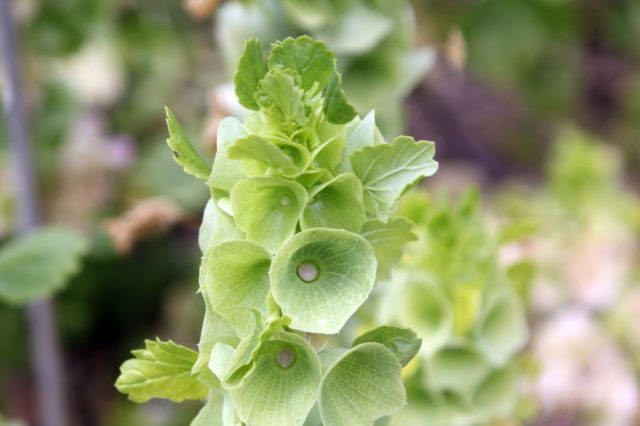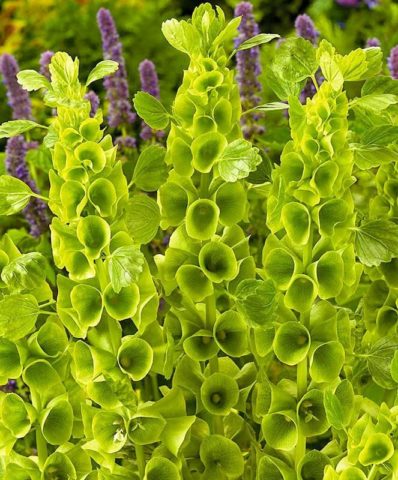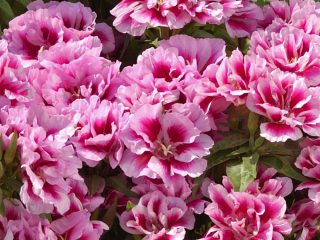Content
Molucella, or Irish bells, can add unusualness and originality to the garden. Their exotic appearance and unconventional shade attract attention and serve as an interesting backdrop for familiar garden flowers. Although the plant has been known for a long time, it is very rare to find it in private gardens.
- Molucella blooms for a very long time
Description and characteristics
Molucella, or Irish bluebells, belongs to the Lamiaceae family, which contains both annual and perennial species. In floriculture, only one is used - smooth molucella, a herbaceous annual. Its homeland is the Mediterranean.
The plant is a bush up to 1 m high with a large number of shoots. They bear round, toothed leaves on long petioles.Small white flowers are located in the stipules, their aroma is pronounced and sweetish. Flowering of molucella begins in mid-summer and continues until September. The seeds are tetrahedral, gray in color, and ripen in early October. Germination persists for three years.
The plant is heat-loving, easily tolerates drought, and can grow in both shade and sun.
It is believed that molucella was popular in Britain back in the Victorian era and, according to the British, brought good luck. It is for this reason that it is called the Irish Bells of Good News. The development of a cultural decorative species belongs not to the British, but to the Belgians.
Types of Molucella
The genus Molucella includes annual plants and short-lived perennials:
- Moluccella aucheri.
- Moluccella fedtschenkoana.
- Moluccella bucharica.
- Moluccella otostegioides Prain.
- Moluccella laevisе.
- Moluccella olgae.
- Moluccella sogdiana.
- Moluccella spinosa.
Only one of them, Moluccella laevis, is grown as an ornamental species.
Molucella varieties
In gardening, several varieties of smooth molucella are used, which differ in size, flowering time and external characteristics. The agricultural technology for growing them is identical, so when caring for plants you can follow a single algorithm.
Emerald
The most popular annual variety of molucella. It is distinguished by its unpretentiousness and low susceptibility to sudden drops in temperature.

Another name for molucella is Moluok lemon balm.
The stem of the “Emerald” molucella reaches a height of 90 cm and is highly branched. Its white small spikelet-shaped inflorescences are located inside green funnel-shaped cups.From mid-summer to September, the flowering of this spectacular plant continues, which is used for cutting and creating landscape compositions.
Enigma
The average height of the shoots of the Enigma molucella is 80 cm. The flowers are in the form of bells, tightly adjacent to the stem. The seedling method is used to grow ornamental plants.

After drying, Enigma retains its green color for up to 5 years.
The Enigma variety is cold-resistant, but during frosts the plant must be covered. Molucella is demanding of heat and moisture and can grow in the shade. It is used in mixborders and to create bouquets of dried flowers.
Green
The variety of annual molucella “Green” has a small growth – up to 60 cm. The shoots are erect, with spike-shaped inflorescences. The funnel-shaped cups contain small white molucella flowers with a slightly perceptible aroma. The variety is undemanding to soil composition and light.

If the stem of Molucella Green branches strongly, you need to install a support
Shy
Despite the name, molucella “Skromnitsa” looks unusual and impressive. The sepals of the plant are light green, bell-shaped. Inside it are spike-shaped white inflorescences. Molucella leaves are round, with teeth along the edges.

The gradual drying out of flowers from the bottom of the shoot is one of the shortcomings of “Skromnitsa”, leading to loss of decorativeness
Santa
The upright stem of the Santa variety bears green bracts and white fragrant buds. The height of the shoots is 70 cm. The flowering period is long - from June until autumn.

To create dry bouquets, molucella “Santa” is harvested in the morning, during the period when the calyxes are fully blooming
Growing Molucella from Seeds
There are two ways to grow Irish bells - using seedlings and sowing seeds in the ground. To obtain healthy, well-developed plants, it is necessary to comply with the timing, rules of planting and caring for molucella.
Timing of sowing seeds
In southern regions with a warm, mild climate, Irish bluebells are sown directly into the ground in early April. In other regions, seedlings are sown in boxes at the end of March. The first shoots appear after two weeks. During this period, you should not hesitate to thin out the plants. It is necessary to remove excess seedlings so that the distance between neighboring specimens is at least 25 cm.
In nature, Irish bluebells reproduce by self-sowing.
Requirements for place and soil
When sowing Irish bells for seedlings, a container with soil mixture is prepared in advance. It should be filled with nutritious soil (peat, humus, turf soil in equal proportions), and covered with a thin layer of sand on top. The soil is warmed up, moistened and then the seeds are sown.
In open ground, choose a sunny place for Irish bells. Slight shade of the area is acceptable. Molucella prefers loose soils without stagnant moisture, with good air permeability. It can grow in poor soil, but develops better in fertile soil. If there is an excess of organic fertilizers, especially fresh manure, there is a high probability of fungal pathologies occurring in the Irish bellflower.

Irish bells can be sown before winter, in October
Sowing seeds and subsequent care
Sowing can be done in boxes and any containers. Having filled them with soil mixture, the seeds of Irish bells, similar to buckwheat, are distributed over the surface of the moistened sand.They should be at a distance of 2.5-3 cm from each other. The seeds are slightly pressed into the sand, sprinkled with a layer of soil no more than 5 mm thick and moistened on top using a sprayer.
The top of the container is covered with glass or film. To create optimal conditions, it is necessary to maintain the air temperature at about 15 ⁰C and diffuse lighting.
Periodically, the greenhouse must be ventilated and the soil moistened. After 1.5-2 weeks, the first seedlings of Irish bells should appear. They may be uneven and take a very long time to emerge (up to 4 weeks).
Picking
After emergence, the sprouts begin to develop rapidly. At the two-leaf stage, they need to be picked into separate pots (peat, plastic containers).
Hardening
2 weeks before planting in open ground, it is necessary to harden off the seedlings of Irish bells. For this purpose, you should often ventilate the room, take containers with seedlings to the loggia, balcony or outside.

In nature, Irish bells grow in India, northern Africa and the Mediterranean
Planting in open ground
Hardened seedlings of Irish bluebells are planted in the garden at a time when the threat of return frosts has disappeared.
The soil is dug up, holes are made according to the size of the root system, taking into account the earthen ball 40 cm from each other. Irish bells are planted using the method of transshipment or with a small lump of earth. Plants are watered and slightly shaded if the chosen location is sunny.
Watering
The main requirement for watering molucella is regularity.If precipitation in the form of rain falls periodically, there is no need to specifically moisten the soil near the plants. When drought and heat persist, abundant irrigation is carried out at least once every 2 days.
Top dressing
Irish bluebells respond quickly to fertilization. They begin to grow well and delight with lush flowering. It is recommended to use mineral complex fertilizers and organic matter. To obtain abundant flowering, fertilize the bushes twice a month.

Fresh manure as a top dressing is detrimental to molucella
Trimming
In order for molucella to remain decorative throughout the season, wilted inflorescences must be removed. Yellowed foliage and damaged shoots are also cut out.
Sowing in the ground
If the Irish bell is sowed in open ground, it is necessary to perform a number of sequential operations:
- Make shallow furrows in the prepared soil.
- Moisturize them.
- Place the seeds at intervals of 2 cm.
- Cover with a small layer of soil.
Further care for Irish bells is the same as for those obtained from seedlings.

Flowers are used to create spectacular wedding bouquets
Diseases and pests
Irish bells have good immunity; they rarely get sick or are attacked by pests. Planting in a damp area, waterlogging as a result of improper watering or rainy weather can lead to root rot. Fungicides and creating favorable conditions for plants help correct the situation.
When and how to collect seeds
Irish bluebell seeds are collected as they ripen.It is necessary to carefully monitor this process so that they do not crumble.
After collection, the seed material is dried, placed in paper bags and stored in a dark, dry, cool place. Under proper maintenance conditions, germination persists for more than 3 years.
Preparing for winter
At the end of autumn, after the first frosts, bushes of annual species of Irish bluebells are removed from the site. Perennial molucellae are cut to stumps, hilled up, covered with leaves or covered with spruce branches.
Molucella in landscape design
Original Irish bells are widely used by landscape designers and ordinary gardeners to give the site originality and uniqueness. The classic option is placement on flower beds, mixborders, in the form of tapeworms and borders. Since the molucella bush is taller than average, most often the plant is placed in the background, using it as a backdrop for other decorative flowers.
Flowerbed
With the help of Irish bells you can create a flowerbed that looks noble and elegant. It is decorated in white and green colors. This option will appeal to those who are tired of brightness and diversity. You can place a flower bed in one of the corners of the garden, highlighting it favorably against the general background. A trio composed of snapdragons with white inflorescences of amaranth and molucella looks impressive. The Irish bell goes well with delphiniums.

Irish bluebells are best planted in a checkerboard pattern.
Mixborders
Mixed plantings have recently been used much more often than flower beds in which flowers are arranged in a clear geometric order. Irish bluebells are planted in the background, creating an original background against which red flowers look most impressive.Tobacco in greenish shades, burgundy lilies, primroses and coleus with crimson foliage can be good companions for molucella.
Exotic design
For lovers of exotic style, Irish bells are a real find. It is recommended to plant them so that they look like candles, and arrange the remaining bright flowers in tiers, reminiscent of a jungle.
As decoration
The long flowering of molucella, its decorative appearance and high growth make it possible to use the plant to hide unsightly areas of plots, part of a fence or building. Hops, marigolds, ferns, lemongrass, lupine, and nasturtium successfully emphasize the unusual nature of Irish bells.
Solo plantings
Single plantings of molucella look beautiful on lawns, near ponds, in pots and containers. They look good as borders and hedges. On rich soils, their height, the size of the flowers and the volume of the bush surprise others.
Conclusion
Irish bells are loved by flower growers for their unusual decorative effect and the ability to realize the most unexpected design ideas. The rare shade of green foliage and beautiful molucella blooms are used to create spectacular bouquets. Growing bells is not difficult; it is important to follow the rules of sowing and caring for the plant.









